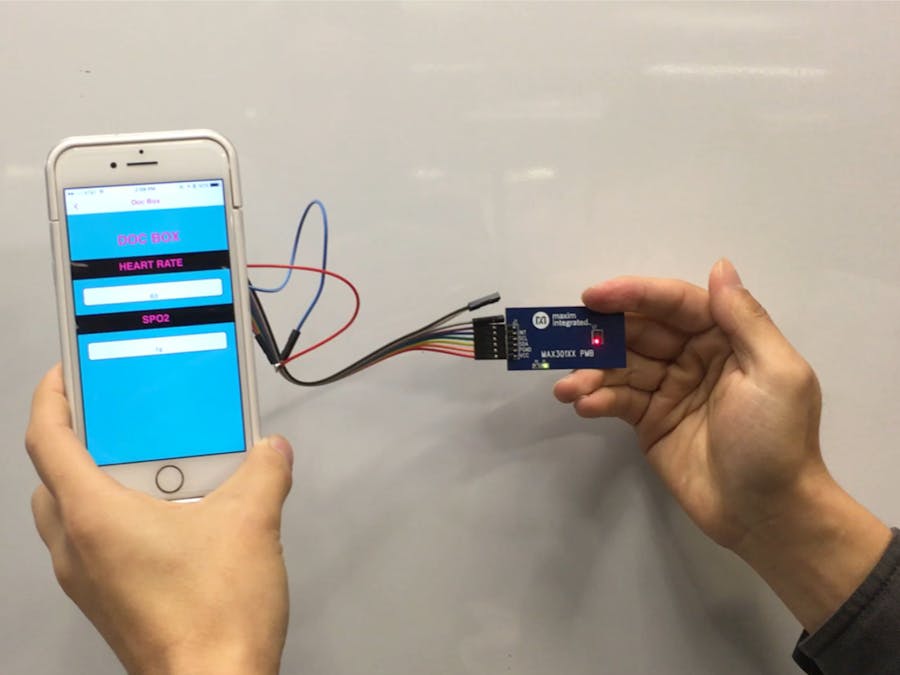Hardware components | ||||||
 |
| × | 1 | |||
 |
| × | 1 | |||
Software apps and online services | ||||||
| ||||||
This is the two-day Aggie Invent competition product sponsored by Maxim Integrated and Nexpaq. Its design purposes are as follows:
- No longer a stand alone device
- Integrated into NEXPAQ products
- Use phone as display
- No independent battery or storage devices (uses phone and NEXPAQ power and storage)
- Remain modular
- Remain portable
- Remain durable
- Remain accurate
heart rate and oxygen sensors
EKG sensor
Modular Design fits into your phone case
More Portable than Existing Product
Flow Chart
Sensor Firmware
C/C++Sense the heart rate and oxygen of human body and transfer the data to the phone UI by I2C protocol
#include "mbed.h"
#include "nexpaq_mdk.h"
#include "algorithm.h"
#include "MAX30102.h"
//DigitalOut ledR(P2_4, LED_OFF);
//DigitalOut ledG(P2_5, LED_OFF);
//DigitalOut ledB(P2_6, LED_OFF);
DigitalIn button(P0_1, PullUp);
/***** Definitions *****/
#define FUNCTION_TABLE_NUM 1
#define UUID_NUM 16 //UUID number is 16, don't change it
#define LOOP_DELAY 100
#define MAX_BRIGHTNESS 255
uint32_t aun_ir_buffer[500]; //IR LED sensor data
int32_t n_ir_buffer_length; //data length
uint32_t aun_red_buffer[500]; //Red LED sensor data
int32_t n_sp02; //SPO2 value
int8_t ch_spo2_valid; //indicator to show if the SP02 calculation is valid
int32_t n_heart_rate; //heart rate value
int8_t ch_hr_valid; //indicator to show if the heart rate calculation is valid
uint8_t uch_dummy;
Serial pc(USBTX, USBRX); //initializes the serial port
PwmOut ledB(P2_6); //initializes the pwm output that connects to the on board LED
DigitalIn INT(P1_3); //pin P13 connects to the interrupt output pin of the MAX30102 // P13 long
/***** Globals *****/
void my_function_CMD_2700(unsigned char *pData, unsigned char len);
const MDK_REGISTER_CMD my_cmd_func_table[FUNCTION_TABLE_NUM] = {
{0x2700, my_function_CMD_2700}, // Command -> function
};
int lastBtn = 1;
unsigned char dataarray[2];
/***** Functions *****/
void my_function_CMD_2700(unsigned char *pData, unsigned char len)
{
unsigned char response = 0x00;
//ledR = (pData[0]>0) ? LED_ON : LED_OFF ;
//ledG = (pData[1]>0) ? LED_ON : LED_OFF ;
//ledB = (pData[2]>0) ? LED_ON : LED_OFF ;
np_api_upload(0x2701, &response, 1);
}
/******************************************************************************/
void app_setup()
{
if ( np_api_register((MDK_REGISTER_CMD*)my_cmd_func_table, FUNCTION_TABLE_NUM) == MDK_REGISTER_FAILD ) {
// Register failed handle code
error("MDK Register Failed");
}
}
void app_loop()
{
dataarray[0] = n_heart_rate;
dataarray[1] = n_sp02;
np_api_upload(0x2800, dataarray, 2);
}
int main(void)
{
np_api_init();
app_setup();
np_api_start();
uint32_t un_min, un_max, un_prev_data; //variables to calculate the on-board LED brightness that reflects the heartbeats
int i;
int32_t n_brightness;
float f_temp;
maxim_max30102_reset(); //resets the MAX30102
// initialize serial communication at 115200 bits per second:
pc.baud(9600); // 115200 long
pc.format(8,SerialBase::None,1);
//wait(1);
//read and clear status register
maxim_max30102_read_reg(0,&uch_dummy);
//wait until the user presses a key
//while(pc.readable()==0)
//{
// pc.printf("\x1B[2J"); //clear terminal program screen
// pc.printf("Press any key to start conversion\n\r");
// wait(1);
//}
//uch_dummy=getchar();
maxim_max30102_init(); //initializes the MAX30102
n_brightness=0;
un_min=0x3FFFF;
un_max=0;
n_ir_buffer_length=500; //buffer length of 100 stores 5 seconds of samples running at 100sps
while(1) {
Thread::wait(LOOP_DELAY); //long
//wait(1); //long
np_api_bsl_chk();
// app_loop();
un_min=0x3FFFF;
un_max=0;
//dumping the first 100 sets of samples in the memory and shift the last 400 sets of samples to the top
for(i=100; i<500; i++) {
aun_red_buffer[i-100]=aun_red_buffer[i];
aun_ir_buffer[i-100]=aun_ir_buffer[i];
//update the signal min and max
if(un_min>aun_red_buffer[i])
un_min=aun_red_buffer[i];
if(un_max<aun_red_buffer[i])
un_max=aun_red_buffer[i];
}
//take 100 sets of samples before calculating the heart rate.
for(i=400; i<500; i++) {
un_prev_data=aun_red_buffer[i-1];
while(INT.read()==1);
maxim_max30102_read_fifo((aun_red_buffer+i), (aun_ir_buffer+i));
if(aun_red_buffer[i]>un_prev_data) {
f_temp=aun_red_buffer[i]-un_prev_data;
f_temp/=(un_max-un_min);
f_temp*=MAX_BRIGHTNESS;
n_brightness-=(int)f_temp;
if(n_brightness<0)
n_brightness=0;
} else {
f_temp=un_prev_data-aun_red_buffer[i];
f_temp/=(un_max-un_min);
f_temp*=MAX_BRIGHTNESS;
n_brightness+=(int)f_temp;
if(n_brightness>MAX_BRIGHTNESS)
n_brightness=MAX_BRIGHTNESS;
}
ledB.write(1-(float)n_brightness/256); // we can write fraction into the led register????!!!! long
maxim_heart_rate_and_oxygen_saturation(aun_ir_buffer, n_ir_buffer_length, aun_red_buffer, &n_sp02, &ch_spo2_valid, &n_heart_rate, &ch_hr_valid);
//send samples and calculation result to terminal program through UART
if (n_heart_rate>200) {
n_heart_rate=255;
}
if (n_sp02>100) {
n_sp02=255;
}
pc.printf(", HR=%i, ", n_heart_rate);
pc.printf("HRvalid=%i, ", ch_hr_valid);
pc.printf("SpO2=%i, ", n_sp02);
pc.printf("SPO2Valid=%i\n\r", ch_spo2_valid);
app_loop();
//wait(1); // long
}
}
return 0;
}





_1x_bGT19vVAby.png?auto=compress%2Cformat&w=40&h=40&fit=fillmax&bg=fff&dpr=2)


Comments